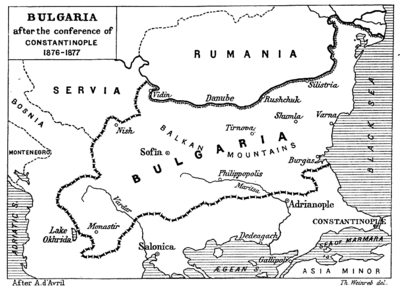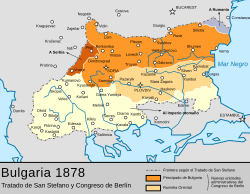Bulgarian Crisis (1885–88)
 Bulgaria following Constantinople Conference 1877 | |
| Native name | Българска криза |
|---|---|
| Date | September 18, 1885 |
| Location | Eastern Rumelia |
| Cause | Union between Eastern Rumelia and Bulgaria |
The Bulgarian Crisis (Българска криза) refers to a series of events in the Balkans between 1885 and 1888 which impacted on the balance of power between the Great Powers and conflict between the Austro-Hungarians and the Russians. It was an episode in the continuing Balkan Crisis as vassal peoples struggled for independence from the Ottoman Empire but achieved a mosaic of nascent nation states (Balkanisation) and featured unstable alliances that frequently led to war, and eventually to the First World War.
Background
Turkey's rejection of the terms of the Constantinople Conference (1876-1877) led to the Russo-Turkish War of 1877–1878. This concluded with the Treaty of San Stefano and the subsequent Treaty of Berlin in 1878 which established an independent Bulgarian principality. The original treaty signed by Russia and Turkey at San Stefano created a greater pro-Russian Bulgaria out of the defeated Ottoman lands. This appeared to contravene earlier secret Russian undertakings both in Reichstadt on July 8, 1876 and later in Budapest between Count Andrassy and the Russian Envoy, Eugene Novikov, (Budapest Convention, 15 January, 18 March 1877). These treaties agreed that in the eventuality of war and a Russian victory that they would not create any large Slavic states. Russia had also traded Austrian neutrality for Bosnia-Herzegovina.[1] [2] [3] [4]
This enlargement of the Russian sphere of influence angered the other Balkan states and alarmed the other great powers who initially threatened war with Russia and then convened the Berlin conference at the behest of Austria's foreign minister Gyula Andrassy to dismantle and rework the provisions of San Stefano. The treaty which also established international recognition of the neighbouring former Ottoman vassal states of Romania, Serbia and Montenegro broke up this 'Greater Bulgaria' into a northern principality of Bulgaria and two southern territories under Ottoman control, Eastern Rumelia and Macedonia. Bosnia and Herzegovina were transferred to Austria-Hungary. Unfortunately the Treaty solved little. It satisfied Britain and Austria-Hungary, but only at the expense of Russia and the peoples of the Balkan states, making further crises inevitable. [5]
Consequently, the future of the Balkan lands was now perceived as a matter for the disposal of the European Great Powers. These events significantly impacted the dynastic relations between Germany and Russia. Consequently, to counterbalance Russian influence and perceived panslavic expansion in the Balkans, Germany and Austria-Hungary concluded a Dual Alliance (Zweibund) in 1879.
Bulgarian unification and Serbo-Bulgarian War


.jpg)
In September 18, 1885, a rebellion and coup in the Ottoman province of Eastern Rumelia, aided by the Bulgarians, saw the people proclaim a union with the new (1878) state of Bulgaria, in violation of the Berlin Treaty of 1878. The union caused consternation amongst the Great European Powers since it altered the power balance in the repeatedly unstable Balkans, and risked Ottoman retaliation and Russian intervention on behalf of Bulgaria. However tension between Alexander III, the Tsar of Russia and the German born Knyaz (Prince) Alexander I of Bulgaria led to the Russians standing aside, withdrawing their troops from Bulgaria and advocating a conference in Constantinople. While the other great powers in general supported Russia's unexpected position the other Balkan powers did not. Both Greece and Serbia felt threatened by the rise of Bulgarian power and declared war on Bulgaria.
Serbia had signed a secret treaty with Austria-Hungary in 1881, and feeling sure that Austria would support them made territorial demands on its western border with Bulgaria, and on being rebuffed declared war on November 14. However, by November 28 Serbia had been defeated by Bulgaria. Further humiliation of Serbia was only prevented by Austrian intervention. Subsequently there was a Russophile coup against Alexander I in 1886 who was replaced by the Austriophile (he was the Austrian Emperor's nephew and an officer in the Austrian army) Prince Ferdinand of Saxe-Coburg and Gotha (1887–1918). The relations between the young Bulgarian state and Russia deteriorated.
Effects on the Great Powers
The events in the Balkans were in a way proxy events for their supporters, Russia and Austria-Hungary, effectively dissolving (1887) the fragile alliance between Germany, Austria and Russia known as the League of Three Emperors (Dreikaiserabkommen) 1873–1878, which had been revived on June 18, 1881. The league provided for mutual aid in the event of an attack on a member and benign neutrality in the event of one of them being involved in conflict outside the League. The terms also provided for consultation on any proposed Balkan operations. This offered Germany Russian neutrality in the event of a further war with France, and Russia the neutrality of Germany and Austria in the event of war with Britain or Turkey. The protocol was secret, and was renewed in 1884. It stated, inter alia:[6]
„4. Die drei Mächte werden sich der etwaigen Vereinigung Bulgariens und Ostrumeliens in den Gebietsgrenzen, die durch den Berliner Vertrag angewiesen sind, nicht widersetzen, wenn diese Frage sich durch die Macht der Dinge erheben sollte.“
(4. The three powers will not oppose the eventual unification of Bulgaria and Eastern Rumelia within the limits set by the Treaty of Berlin, should this eventuality occur by force of circumstances)
When this eventually occurred, the situation was more complicated. Prince Alexander of Battenberg had been elected in 1879 as Prince of Bulgaria at the request of the Russian Tsar, his uncle, Alexander II. Prince Alexander found himself obliged to support the nationalist movement for re-unification despite the advice of the Russian ministers and advisers, but with the apparent support of the British Prime Minister, Gladstone, an opponent of Russia's position. Russia then withdrew its ministers and advisers from Bulgaria.
Another complication was the role of King Milan of Serbia, an ally of Austria, another opponent of Russia in the Balkans. The King sought territorial compensation from Bulgaria. When he did not receive it, he declared war in 1885. Defeated, Serbia saw Bulgarian troops reach Belgrade before Austria intervened. The subsequent Treaty of Bucharest in March 1886 essentially restored the status quo.[7]
The Great Powers and the Porte finally accepted the Unification of Bulgaria through the Tophane Agreement in 1886. Russia, however, was not satisfied and the Russian Tsar, Alexander III, refused to recognise Prince Alexander as ruler of the new enlarged Bulgaria. Subsequently a Russian backed coup, involving a group pro-Russian officers, forced Prince Alexander to abdicate on 9 August 1886. He was then exiled to Russia. When, in a counter-coup, Prince Alexander I returned to the Bulgarian throne, Russia broke off diplomatic relations with Bulgaria.
The Great Powers which were in a constant fear of war between them continued with a series of complicated agreements and alliances, many of which were secret, as deterrents to each other's actions, largely at the behest of Bismark. These included the Triple Alliance which replaced the Dual Alliance in 1882 by including Italy, two Mediterranean Agreements (Mittelmeerentente) in 1887 and the Reinsurance Treaty (1887). Finally publication of the terms of the 1879 treaty persuaded Russia that further action was not in its interests and withdrew from involvement in Bulgaria, and the fear of war dissipated. Bismark's strategy though arcane was largely successful in averting war during his time in office (1871–1890). Unfortunately these arrangements which were heavily dependent on Bismark, failed to provide long term solutions.
See also
- Eastern Question
- History of the Balkans
- History of Bulgaria
- Principality of Bulgaria
- Decline of the Ottoman Empire
- Causes of World War I
References
- ↑ Hugh Ragsdale (ed.) Imperial Russian Foreign Policy. Woodrow Wilson Center Press. Cambridge University Press, 1993. ISBN 052144229X, 780521442299
- ↑ Frederick Kellogg. The Road to Romanian Independence. Purdue University Press, 1995. ISBN 1557530653, 9781557530653
- ↑ Mikulas Fabry. The Idea of National Self-Determination and The Recognition of New States at The Congress Of Berlin (1878). ISA Annual Convention, New Orleans, March 24-27, 2002
- ↑ Pribram, Alfred, ed. (1921) The Secret Treaties of Austria-Hungary. Vol. 2. Cambridge, MA: Harvard University Press.
- ↑ Encyclopædia Britannica: Congress of Berlin
- ↑ Text of the Protocol of the league of Three Emperors 1881
- ↑ Lothar Gall, Bismarck. Der weiße Revolutionär, Frankfurt 1980, ISBN 3 549 07397 6, p. 619 ff.
Sources
- Crampton, R. J. A Concise History of Bulgaria Cambridge UP 1997
- Präliminarfriede von San Stefano in: Konferenzen und Verträge. Vertrags-Ploetz. Handbuch der geschichtlich bedeutsamen Zusammenkünfte und Vereinbarungen. Teil II. 1493 - 1952. Helmuth Rönnefahrt (ed.). Bielefeld: A. G. Ploetz Verlag, 1953, pp. 351f
- Istvän Diöszegi: Kälnoky, Andrässy und die bulgarische Krise 1885–1887. In: Bulgarian Historical Review 3 (1985) pp. 54–59.
- Barbara Jelavich: Russia, Britain and the Bulgarian Question 1885–1888. In: Südostforschungen 32 (1973) pp. 168–191.
- M. Ju. Zolotucbin: Bolgarskij krizis 1885-1886 gg. i krach avstro-russko-germanskogo sojuza (The Bulgarian 1885-1886 crisis and the collapse of the Austro-Russian-German alliance) In: Voprosy istorii 4 (1984), pp. 43–56.
Timeline
- League of Three Emperors 1873-1887
- Reichstadt Agreement 1876
- Constantinople Conference (1876-1877)
- Budapest Convention 1877
- Russo-Turkish War (1877–1878)
- Treaty of San Stefano 1878
- Congress of Berlin
- Treaty of Berlin (1878)
- Dual Alliance, 1879
- Austro-Serbian Alliance 1881-1895
- Triple Alliance 1882
- Bulgarian unification 1885
- Serbo-Bulgarian War 1885
- Treaty of Bucharest (1886)
- Bulgarian coup 1886
- Tophane Agreement 1886
- Mediterranean Agreements 1887
- Reinsurance Treaty 1887-1890